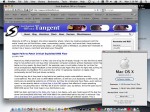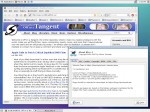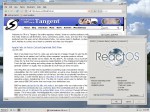A bit over a year ago now, I posted nerdy screenshots of a whole bunch of operating systems. I’m a bit of an OS junkie, which is probably a strange thing to be but . . . oh well. Ever since I got my MacBook Pro I’ve been able to run an ungodly number of operating systems through VMWare Fusion, Q, and SheepShaver—from the biggies like Mac, Linux, and Windows to the obscure like Haiku and FreeDOS and oldies like Windows 3.11 and BeOS.
Anyway, there have been a lot of updates in the operating system world since last year, so here’s a new version for your enjoyment (or for you to ignore ;-)).
The Big League
 Apple Mac OS X 10.5.4—Mac OS X was and remains my primary operating system for day-to-day use. I switched to Mac in 2001 and have not yet regretted the decision. I find Mac OS to be the most solid, reliable, and usable operating system available today. It’s easy enough for a novice, but powerful enough for a nerd (it is, after all, a pretty face put on top of a BSD-derived UNIX core). There was a bit of a rough transition from 10.4 ‘Tiger’ to 10.5 ‘Leopard’, but most of those kinks were worked out within a month or two (Windows Vista users had to wait almost a year for their first service pack).
Apple Mac OS X 10.5.4—Mac OS X was and remains my primary operating system for day-to-day use. I switched to Mac in 2001 and have not yet regretted the decision. I find Mac OS to be the most solid, reliable, and usable operating system available today. It’s easy enough for a novice, but powerful enough for a nerd (it is, after all, a pretty face put on top of a BSD-derived UNIX core). There was a bit of a rough transition from 10.4 ‘Tiger’ to 10.5 ‘Leopard’, but most of those kinks were worked out within a month or two (Windows Vista users had to wait almost a year for their first service pack).
 Ubuntu Linux 8.04.1—Ubuntu—specifically the Xubuntu variant—has become my primary operating system for non-Mac hardware, and is also installed in VMWare Fusion on my Mac. Version 8.04, also known has the ‘Hardy Heron’, is a very solid release and it comes with ‘long term support’, meaning security updates will be provided for several years. This makes it a good Linux distribution to deploy in a corporate environment or on servers. I run Ubuntu on diverse hardware, including an 8-year-old Dell workstation (which is now our home network server) and a few-months-old Asus Eee PC subnotebook, without any serious problems.
Ubuntu Linux 8.04.1—Ubuntu—specifically the Xubuntu variant—has become my primary operating system for non-Mac hardware, and is also installed in VMWare Fusion on my Mac. Version 8.04, also known has the ‘Hardy Heron’, is a very solid release and it comes with ‘long term support’, meaning security updates will be provided for several years. This makes it a good Linux distribution to deploy in a corporate environment or on servers. I run Ubuntu on diverse hardware, including an 8-year-old Dell workstation (which is now our home network server) and a few-months-old Asus Eee PC subnotebook, without any serious problems.
 Microsoft Windows 5.1 (XP) SP3—For better or worse, Windows is what the world runs. I don’t know why, and it seems to make less and less sense as time goes by, but that is the reality. Thus, while I have moved on to better alternatives, I still have to keep a Windows install around for testing and (on rare occasion) to access a Windows-only web site or piece of software. While Microsoft continues to foist their Vista beta test on the world, I’m sticking with the previous version—XP—for the time being, as are most businesses and consumers, since it’s more reliable and trustworthy. My primary usage at this point is testing in Windows browsers, running mobile phone emulators, and so on.
Microsoft Windows 5.1 (XP) SP3—For better or worse, Windows is what the world runs. I don’t know why, and it seems to make less and less sense as time goes by, but that is the reality. Thus, while I have moved on to better alternatives, I still have to keep a Windows install around for testing and (on rare occasion) to access a Windows-only web site or piece of software. While Microsoft continues to foist their Vista beta test on the world, I’m sticking with the previous version—XP—for the time being, as are most businesses and consumers, since it’s more reliable and trustworthy. My primary usage at this point is testing in Windows browsers, running mobile phone emulators, and so on.
Experimental/Special Purpose
 Haiku OS—Haiku is one of my favorite open source software projects, and I’m really looking forward to its eventual release in a final form. Inspired by the defunct BeOS operating system (see below), Haiku seeks to be a user-oriented alternative to more server-oriented products like Linux. I didn’t discover BeOS until long after it was dead, but having played with it now it’s pretty slick and interesting. Haiku has improved by leaps and bounds over the last year, with networking up-and-running. Even better, the BeOS port of the Firefox 2.0 web browser now runs successfully on Haiku, which means that the system can now be used to surf the web just like any other system. It has some instability problems overall (expected at this stage of development), but it’s constantly getting better.
Haiku OS—Haiku is one of my favorite open source software projects, and I’m really looking forward to its eventual release in a final form. Inspired by the defunct BeOS operating system (see below), Haiku seeks to be a user-oriented alternative to more server-oriented products like Linux. I didn’t discover BeOS until long after it was dead, but having played with it now it’s pretty slick and interesting. Haiku has improved by leaps and bounds over the last year, with networking up-and-running. Even better, the BeOS port of the Firefox 2.0 web browser now runs successfully on Haiku, which means that the system can now be used to surf the web just like any other system. It has some instability problems overall (expected at this stage of development), but it’s constantly getting better.
 ReactOS 0.3.5—The idea behind ReactOS is to create an open source operating system that is compatible with software and device drivers written for Microsoft Windows. Loosely related to the Wine project, which allows you to run Windows software on non-Windows operating systems, I’ve been pretty disappointed with the compatibility at this stage. In the screenshot, you can see some of the visual goofiness that affects Firefox and that, along with general instability, makes ReactOS useless for day-to-day usage. Hopefully things will get better, and the development is in a pretty early stage still, but Wine hasn’t inspired confidence since they call themselves a ‘1.0’ product without supporting most Windows applications I’ve tried to run.
ReactOS 0.3.5—The idea behind ReactOS is to create an open source operating system that is compatible with software and device drivers written for Microsoft Windows. Loosely related to the Wine project, which allows you to run Windows software on non-Windows operating systems, I’ve been pretty disappointed with the compatibility at this stage. In the screenshot, you can see some of the visual goofiness that affects Firefox and that, along with general instability, makes ReactOS useless for day-to-day usage. Hopefully things will get better, and the development is in a pretty early stage still, but Wine hasn’t inspired confidence since they call themselves a ‘1.0’ product without supporting most Windows applications I’ve tried to run.
 FreeDOS 1.0—Remember DOS? When Microsoft announced in the mid-1990s that they were killing MS-DOS as a standalone product, the FreeDOS project was founded to create an open source alternative. While it didn’t finally reach ‘1.0’ status until the 2000s, FreeDOS is a modernized and improved DOS that is, in my limited testing, very compatible with software originally written for MS-DOS. For the general user its usefulness is probably quite limited, but for those of us who cut our teeth on DOS it’s a wonderful operating system to play around with and refresh our memories. It’s also pretty nice that they included the standard UNIX commands, so if you type ‘ls’ instead of the correct DOS command ‘dir’ the right thing still happens. That’s good, since most of my command-line use nowadays is on Linux and UNIX systems.
FreeDOS 1.0—Remember DOS? When Microsoft announced in the mid-1990s that they were killing MS-DOS as a standalone product, the FreeDOS project was founded to create an open source alternative. While it didn’t finally reach ‘1.0’ status until the 2000s, FreeDOS is a modernized and improved DOS that is, in my limited testing, very compatible with software originally written for MS-DOS. For the general user its usefulness is probably quite limited, but for those of us who cut our teeth on DOS it’s a wonderful operating system to play around with and refresh our memories. It’s also pretty nice that they included the standard UNIX commands, so if you type ‘ls’ instead of the correct DOS command ‘dir’ the right thing still happens. That’s good, since most of my command-line use nowadays is on Linux and UNIX systems.
Memory Lane (Legacy)
 Apple Mac OS ‘Classic’ 9.0.4—The SheepShaver application allows you to run the ‘classic’ Mac OS up to version 9.0.4 on Intel-based Macs, though with a slight speed hit. It’s not particularly useful these days except as an exercise in nostalgia, since the most modern web browser available—the unofficial Mozilla Suite 1.31—is no longer very modern. In fact, while compiling my screenshots for this piece, I discovered that compatibility with my site finally broke when I launched the current version and there is no longer any practical way for Mac OS ‘Classic’ users to view my web site correctly. That’s okay though; there are virtually no Mac OS ‘Classic’ users left.
Apple Mac OS ‘Classic’ 9.0.4—The SheepShaver application allows you to run the ‘classic’ Mac OS up to version 9.0.4 on Intel-based Macs, though with a slight speed hit. It’s not particularly useful these days except as an exercise in nostalgia, since the most modern web browser available—the unofficial Mozilla Suite 1.31—is no longer very modern. In fact, while compiling my screenshots for this piece, I discovered that compatibility with my site finally broke when I launched the current version and there is no longer any practical way for Mac OS ‘Classic’ users to view my web site correctly. That’s okay though; there are virtually no Mac OS ‘Classic’ users left.
 Microsoft Windows 5.0 (2000) SP4—I stuck with Windows 2000 as long as I could, but when Vista came out a lot of software products began dropping official Windows 2000 support. It’s got the same core as Windows XP, but without all the junk, so I really liked this version. In fact, an argument can be made that Windows 2000 was the best, most reliable, most pleasureable to use version of Windows that Microsoft has ever produced. But since I need to test on relatively current software, I’ve moved up to Windows XP as my ‘primary’ Windows install. I am keeping my Windows 2000 install around though, since I need a separate install of Windows to test in Internet Explorer 6 (Microsoft doesn’t allow you to install two versions of IE side-by-side on the same copy of Windows for some reason).
Microsoft Windows 5.0 (2000) SP4—I stuck with Windows 2000 as long as I could, but when Vista came out a lot of software products began dropping official Windows 2000 support. It’s got the same core as Windows XP, but without all the junk, so I really liked this version. In fact, an argument can be made that Windows 2000 was the best, most reliable, most pleasureable to use version of Windows that Microsoft has ever produced. But since I need to test on relatively current software, I’ve moved up to Windows XP as my ‘primary’ Windows install. I am keeping my Windows 2000 install around though, since I need a separate install of Windows to test in Internet Explorer 6 (Microsoft doesn’t allow you to install two versions of IE side-by-side on the same copy of Windows for some reason).
 Microsoft Windows 3.11—You want a real exercise in nostalgia, here’s a look at my Windows 3.11 install. I have no reason whatsoever for having this on my computer, except that Windows 3.11 was the first version of Windows I ever used and it’s nice to open it up now and then and laugh at what we used to consider sufficient in our computer universe. I mean, really, ever try to get anything done in Windows 3.11? It was rough.
Microsoft Windows 3.11—You want a real exercise in nostalgia, here’s a look at my Windows 3.11 install. I have no reason whatsoever for having this on my computer, except that Windows 3.11 was the first version of Windows I ever used and it’s nice to open it up now and then and laugh at what we used to consider sufficient in our computer universe. I mean, really, ever try to get anything done in Windows 3.11? It was rough.
 Be Inc. BeOS 5 PE—The inspiration behind Haiku (see above) was the BeOS. Brought into the world by a bunch of former Apple engineers and pitched to Apple as a potential replacement for the ‘Classic’ Mac OS, Be Inc. spiraled into oblivion two or three years after Apple went with NeXTstep (and Steve Jobs) instead of BeOS as the basis for the new Mac OS. NeXTstep became what we now know as Mac OS X, and Be Inc. was bought-out by Palm and BeOS discontinued. While it never made a big splash in the marketplace, BeOS was an excellent multimedia operating system for its day and still has a small but active community of users and supporters.
Be Inc. BeOS 5 PE—The inspiration behind Haiku (see above) was the BeOS. Brought into the world by a bunch of former Apple engineers and pitched to Apple as a potential replacement for the ‘Classic’ Mac OS, Be Inc. spiraled into oblivion two or three years after Apple went with NeXTstep (and Steve Jobs) instead of BeOS as the basis for the new Mac OS. NeXTstep became what we now know as Mac OS X, and Be Inc. was bought-out by Palm and BeOS discontinued. While it never made a big splash in the marketplace, BeOS was an excellent multimedia operating system for its day and still has a small but active community of users and supporters.
 Microsoft MS-DOS 6.22—The operating system on which I became a true nerd was MS-DOS 5.22, and a bit later MS-DOS 6.22. This is actually the same VMWare install as Windows 3.11 (above), since MS-DOS (or another DOS) was a prerequsite for running Windows up until Windows 95 pretended to merge them together. If you actually need to get anything done in DOS anymore, FreeDOS is the way to go. But it’s nice to fire up the real-deal MS-DOS now and then to remember what it was like way-back-when.
Microsoft MS-DOS 6.22—The operating system on which I became a true nerd was MS-DOS 5.22, and a bit later MS-DOS 6.22. This is actually the same VMWare install as Windows 3.11 (above), since MS-DOS (or another DOS) was a prerequsite for running Windows up until Windows 95 pretended to merge them together. If you actually need to get anything done in DOS anymore, FreeDOS is the way to go. But it’s nice to fire up the real-deal MS-DOS now and then to remember what it was like way-back-when.
